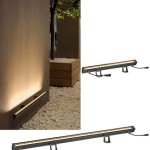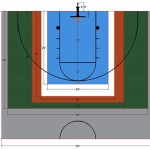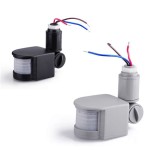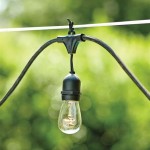Photocell Sensor for Outdoor Lights: A Guide to Automatic Illumination
Photocell sensors, often referred to as light sensors, are essential components in modern outdoor lighting systems. These devices automatically switch lights on and off based on the intensity of ambient light, providing energy efficiency, security, and convenience. By leveraging the natural cycle of daylight and darkness, photocell sensors contribute to a sustainable and secure environment.
How Photocell Sensors Work
Photocell sensors operate on a simple principle: they detect changes in light levels. These sensors typically employ a cadmium sulfide (CdS) photoresistor, a component whose electrical resistance varies inversely with the intensity of light. When the ambient light falls below a predetermined threshold, the resistance of the photoresistor increases, triggering the relay within the sensor to activate the connected lights. As the light level rises again, the resistance decreases, switching off the lights.
Types of Photocell Sensors
Photocell sensors come in various forms, each tailored for specific applications and environments. The most common types include:
- Built-in Sensors: These sensors are integrated directly into the fixture, offering a discreet and compact solution for outdoor lights. They are often found in post lamps, wall-mounted fixtures, and security lights.
- Standalone Sensors: Standalone sensors are independent units that can be mounted separately and connected to multiple lights. This provides flexibility to control larger areas or multiple fixtures.
- Wireless Sensors: Wireless photocell sensors utilize radio frequency (RF) technology to communicate with the connected lights, eliminating the need for wiring. These sensors are particularly useful for remote or hard-to-reach locations.
Benefits of Using Photocell Sensors for Outdoor Lights
The use of photocell sensors offers numerous benefits for both homeowners and businesses, including:
Energy Efficiency
Photocell sensors eliminate the need for manual operation, ensuring that lights are only activated when necessary. By automatically switching off lights during daylight hours, these sensors significantly reduce energy consumption and save on electricity costs.
Security Enhancement
Outdoor lights equipped with photocell sensors provide effective deterrents against crime. The automatic activation of lights at dusk creates a well-lit environment, discouraging potential intruders and enhancing the overall security of the property.
Convenience and Automation
Photocell sensors eliminate the need for manually switching lights on and off, providing convenience and automation. They ensure that lights are always activated when needed, such as during evening walks or when arriving home in the dark, without requiring any manual intervention.
Extended Fixture Lifespan
The automatic operation of photocell sensors reduces the frequency of ON/OFF cycles for the lights, which in turn minimizes wear and tear on the bulbs. This extended lifespan translates to fewer replacements and lower maintenance costs.
Factors to Consider When Choosing Photocell Sensors
When selecting a photocell sensor, several factors should be considered to ensure optimal performance and compatibility with the specific application:
Sensitivity
The sensitivity of a photocell sensor determines its response to changes in light levels. A more sensitive sensor will activate lights in darker conditions, while a less sensitive sensor may require a lower level of darkness before triggering the light. The desired level of sensitivity depends on the specific requirements of the application.
Time Delay
The time delay setting controls the duration for which the light remains activated after the ambient light falls below the threshold level. This setting is crucial for providing sufficient illumination during transitions between daylight and darkness, as well as for preventing unnecessary light activation due to fleeting shadows or transient light changes.
Installation
The installation process of a photocell sensor varies depending on the type of sensor and the specific application. Built-in sensors typically require a simple wiring connection to the existing fixture, while standalone sensors may necessitate an external mounting location and additional wiring. It is important to consider the installation complexity and the availability of appropriate mounting locations when choosing a sensor.
Compatibility
It is essential that the chosen photocell sensor is compatible with the type of lights being controlled. Different sensors may be compatible with different types of bulbs (LED, CFL, incandescent) and wattage ratings. Refer to the manufacturer's specifications to ensure compatibility before purchasing a sensor.
Conclusion
Photocell sensors are a valuable asset for modern outdoor lighting systems. By automating the activation of lights based on ambient light levels, they provide energy efficiency, security enhancement, convenience, and extended fixture lifespan. When selecting a photocell sensor, factors such as sensitivity, time delay, installation, and compatibility should be carefully considered to ensure optimal performance for the specific application.

Solus Photocell Light Sensor Switch For Hardwire Outdoor Lamp Posts With Ezee Change Plug Dusk To Dawn Control

Ip54 Outdoor Light Sensor Switch Photocontrol China Photocell Control Made In Com

Wall Mounted Photocell Sensor Outdoor Lighting

Installing A Photocell Sensor
Hot Photocell Twist Lock Sensor Blue Light Switch Locking For Outdoor Lighting 3pcs Durable Ee Singapore

Photocell Outdoor Lighting Twist Cap Dusk To Dawn Sensor

Haoan Twist Lock Photocell For Outdoor Lights Sensor Photo Control Light Dusk To Dawn Com

Light Sensor Outdoor Lighting At Com

Maximize Energy Efficiency Photocell Sensors For Outdoor Lighting Light Bulb Surplus

Ip54 Outdoor Light Sensor Switch Photocontrol China Photocell Control Made In Com
Related Posts








